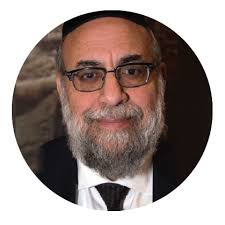Why Personal Change Is Not Enough

We can do things to improve our homes, our shuls, our communities, and beyond
N
early a year ago, an essay of mine titled “Era of Hidden Faces” appeared in these pages on the topic of hester Panim. In the lead-up to last Tishah B’Av, I tried to analyze the many tragedies that had taken place in the months prior, and the Meron tragedy in particular. I observed that even after all those hard shocks, each new one more painful and devastating than the last, we still had not seen any change in Klal Yisrael — or in “Reb Yisrael.”
Reactions from readers came pouring in. Even now, I’m still hearing their comments — no longer in written form, but rather verbally, while standing at a reception at a chasunah, following the Kosel neitz minyan, or sometimes in the aisles at Gourmet Glatt. I seem to have struck a nerve — a raw nerve.
Many disagreed; some were even offended, and others even took the time and space to share how they have changed. The general thrust of the responses was that change is internal; it comes from within, and may not be visible even to the most discerning eye. Perhaps the most notable response came several months ago at the Agudah Convention: I was both honored and humbled when one of the leading roshei yeshivah of our day politely called me over and whispered to me the personal kabbalah he had undertaken, which I took as a mild rebuke to the hypothesis in my article.
I stand my ground.
I would never be so bold as to make the claim that I know what’s in people’s hearts. Only HaKadosh Baruch Hu has that ability. And of course, what Yid with a beating heart would not react to these incomprehensible tragedies? My point was that these individual kabbalos and inner changes had not manifested themselves in the external behavior of our Torah tzibbur.
Our weddings haven’t changed (some might even venture to say that they’ve been ratcheted up a notch or two). My rabbinic colleagues have noted that our shul decorum hasn’t changed for the most part. And we would be hard pressed to find a beis din that would report a reduction in their annual caseload. As a matter of fact, the beis din for monetary disputes that I have been fortunate to lead for the past 20-plus years has seen its previous monthly average of three to four cases now double.
So, in hindsight, I think I should have made clearer that I was referring to collective change rather than individual change — not change in “Reb Yisrael,” but rather in Klal Yisrael.
That, of course, begs the question; as many have indeed asked, shouldn’t the priority be individual change? The Baalei Mussar all speak about the difficulty of a person changing even one middah. Rav Yisrael Salanter said that if a person spends 40 years of his life working on shemiras halashon, that prolonged effort is considered worthwhile even if it only helps him refrain from the aveirah one time.
So if an individual reacts to communal tragedy by taking on a new kabbalah, shouldn’t that be a sufficient response? Wouldn’t HaKadosh Baruch Hu be satisfied with such an individual change?
Regretfully, I believe the answer is no.
Our greatest Torah leaders, from the Chofetz Chaim to the Chazon Ish to the recently departed Sar HaTorah, Rav Chaim Kanievsky, didn’t just work on themselves to achieve personal greatness; they gave of themselves in every way to effectuate change in Klal Yisrael. Each of these and many others like them didn’t just leave behind brilliant seforim, or the inspiration of how great an individual can become; they also achieved real communal change.
The rest of us, who are not the gedolei hador, cannot accomplish major change in Klal Yisrael, nor are we expected to; however, we can do things to improve our homes, our shuls, our communities, and beyond. This magazine has featured stories over the last few years about individuals from ordinary backgrounds with abilities like the rest of us who were able to wield major communal influence.
I’ll cite one small example of this from my own community. Right after the petirah of Rav Chaim ztz”l on Shushan Purim, there was supposed to be a post-Purim party, scheduled to take place on Motzaei Shabbos — the night before the levayah. It was to be a grand, festive affair featuring live music, a fully stocked open bar, meat-carving stations, and enough food to feed the several hundred guests expected to attend.
I received a call from an individual with a very sensitive soul, someone I would describe as the opposite of an askan. He called to express his outrage about this party, saying it was “meiso mutal b’fanav.” The whole Torah world was shattered and frightened at the prospect of a world without Rav Chaim, and here frum Yidden would be celebrating a post-Purim party. Knowing that I had a close relationship with Rav Chaim, he was asking me to intercede and halt this chillul Hashem.
I replied that while I did believe that the party was totally inappropriate at such a time, I would not get involved. I explained that first, I did not know any of the organizers personally. Furthermore, if they themselves didn’t understand how ill-timed this was, when all of Klal Yisrael were aveilim, then any efforts to get them to cancel it would be futile.
While he was disappointed to hear that, he respectfully said that he understood.
Several days later, I heard from him again. He called to tell me that not only had the party been canceled, the would-be participants had agreed to divide up the recital of Tehillim for a zechus for Rav Chaim that night, and in less than an hour, they completed Tehillim ten times.
How had this happened? Simple enough: This person had personally called the host to explain the inappropriateness of having such a party on this night, and rather than getting angry at his mixing in, the host said he actually wanted to cancel it, but was apprehensive about disappointing all the invitees.
The caller requested the contact info of all the invited guests, and proceeded to send each and every one of them a beautiful email describing who Rav Chaim was and explaining why this was not the time for such a party. Almost all of them responded in agreement. Then he suggested that with the party called off, maybe everyone could instead do something for Rav Chaim’s neshamah. One person proposed saying Tehillim, and in just minutes, the entire sefer was divided up and completed a total of ten times.
I was left speechless. Here I had begged off getting involved, expecting a blanket rejection from the crowd, and now this non-askan had brought about an incredible kiddush Hashem and zechus for Rav Chaim — only because he channeled his internal pain for the loss of Rav Chaim to make a difference for the community. He succeeded where I had failed.
There are so many other examples of people who changed not only themselves but their communities as well. Chazal often speak about the galus ending when Klal Yisrael as a unit reach out together to come closer to Hashem. But individuals who achieve that closeness, even when they reach the highest levels possible, cannot and will not bring us to the end of galus.
Truth be told, maybe in the complex and confusing world that we live in, just holding on tight to what we have and keeping to what we already do is all that Hashem expects of us a tzibbur. Or maybe not.
At the end of Megillas Esther, we find the pasuk that describes the tax that Achashveirosh imposed on his subjects, and it spells his name there with a missing letter vav.
Rav Mordechai Druk ztz”l explains that Achashveirosh had just witnessed the many open miracles described at length in the Midrash for Megillas Esther. One example: When he stretched out his sharvit hazahav, the golden staff, to Esther Hamalkah, it miraculously stretched until it reached her hand. Yet after seeing all these miracles, he still remained the “same old Achashveirosh”; so a letter is removed from his name.
Not so Klal Yisrael.
When they witnessed all the open miracles done on their behalf, there was a reaffirmation and renewal of kabbalas haTorah. They changed. They improved. And they drew even closer to their Creator than they had been at Maamad Har Sinai.
One of the great Baalei Mussar of the last generation once pointed out to me that we always focus on the fact that Yisro was the only one to be so inspired by what he witnessed that he came to join Klal Yisrael. We need to also focus on the fact that no one else in the entire world did.
Chazal relate that the Divine revelation at Krias Yam Suf was so overwhelming that what a simple non-Jewish maidservant saw there, even the greatest of the Neviim in later generations didn’t see. Yet what happened to all the maidservants after it was over? Absolutely nothing. They went back to being lowly maidservants.
The Ramban explains that as great as the moment of Krias Yam Suf was, the “wonder of wonders” was the fact that the Egyptian army saw the waters split and Klal Yisrael walk right through, yet their only response was to keep on going, right into the Yam Suf itself.
This is the nature of man, explains Rav Dessler: to witness open miracles or incredibly painful tragedies, one after the other, and to just keep on going in the same direction, without missing a step.
Yes, individual change is important and even valuable, but it doesn’t translate into a collective meaningful change that will usher in the days of Mashiach.
Since the appearance of my article last year, the confusion, darkness, and pain in the world over has increased exponentially. The horrific war in Ukraine, with images of death and indescribable destruction seared into our hearts and into our minds. The seemingly never-ending brutality and pain thrust upon Acheinu Beis Yisrael in the Holy Land by our cousins, aptly described by the Torah as “pere Adam.” And the thought, previously incompressible, that we would have to live in a world without the Sar HaTorah, Rav Chaim Kanievsky ztz”l.
We have had to endure so much more of Chevlei Mashiach. And if we had to compare ourselves from then to now, how would we look? I have no doubt that we look great; after all, we are the Am Hanivchar.
However, could we possibly look even better?
As the period of Sefiras Ha’omer rapidly comes to a close, and we have been counting each day on the way to Shavuos, are we in the same place we were when we counted yom echad la’Omer? If yes, why? The answer is because real change is so very hard to achieve. Without access to the Urim V’Tumim, we cannot know precisely what Hashem expects of us in these days of chevlei Mashiach — more Torah? More bein adam l’chaveiro? All of the above?
All we do know is that pain abounds, and that if HaKadosh Baruch Hu has taken so many of gedolei Yisrael from us in the last few years, then He expects us to be able to figure it out for ourselves somehow. This means we have the ability; we just need the will.
All of us are heartbroken at the terrible situation of the Jews in Ukraine, but some said “oy” while others started a fundraising campaign for them. On Pesach, one of the campaign heads told me that they dreamed of a goal of $5 million, but they thought that was overreaching. Today their goal is $50 million.
That’s what individual, motivated, concerned Yidden who join together can accomplish for Klal Yisrael. They make a difference. We all just need the motivation and determination to do the same. How do we achieve that? The fact that the Navi promises “u’machah Hashem dimah me’al kol panim,” that Hashem will wipe away the tear from every Jewish face, should be enough to motivate us.
On the last Purim of the Chiddushei Harim’s life, he was already very weak and couldn’t speak very much. At his seudah, he began his derashah with a question: Why does the Megillah start off with a story about a Persian king and his wife, Vashti, and then all the little details about his palace and the party that he threw for himself? Who needs to know about all this?
After a long pause during which he was lost in thoughts, he explained, “Because in the time of Mashiach, many strange things will happen. No one will understand what is going on. And then suddenly, they will realize that it was all tied to the Geulah.”
This, the Rebbe explained to his chassidim, and to us, is the story and the message of the Megillah.
Indeed, a lesson worth thinking about each and every day.
(This article is written l’zecher nishmas Sara Chaya bas Rav Chaim Aryeh Zev)
Rabbi Aryeh Z. Ginzberg is the rav of the Chofetz Chaim Torah Center of Cedarhurst and the founding rav of Ohr Moshe Institute in Hillcrest, Queens. He is a published author of several sifrei halachah, and a frequent contributor to many magazines and newspapers, where he writes the Torah hashkafah on timely issues of the day. He is also a sought-after lecturer on Torah hashkafah at a variety of venues around the country.
(Originally featured in Mishpacha, Issue 912)
Oops! We could not locate your form.







